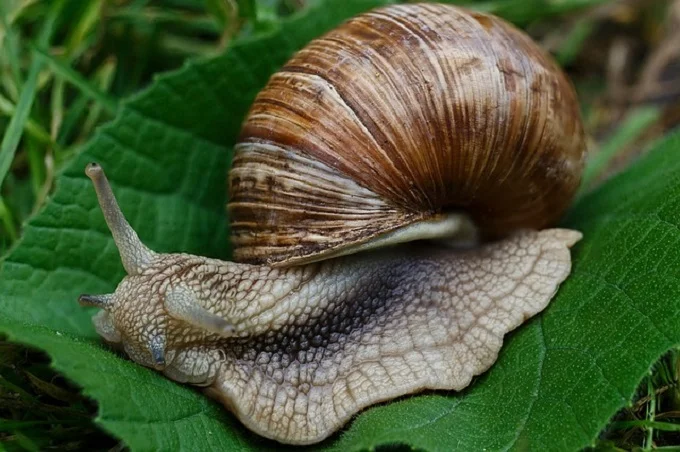When salt comes into contact with snails and slugs, it initiates the osmosis process—their fast dehydration results in their death. Let us attempt to ascertain why this is occurring.
The rainy season provides a refreshing wind, a shroud of gloomy clouds, and an abundance of unwanted visitors. To begin, we’re discussing snails and slugs! This is every gardener’s worst nightmare – they crawl all over the plants, doing havoc on the leaves and roots. Despite their small stature, slugs have a strong appetite that permits them to consume their weight many times each day.
The distinctions between snails and slugs
Is there a distinction to be made between snails and slugs? Both snails and slugs are classified as Mollusca and Gastropoda. The class is named from the Greek terms gastros and podos, translated as stomach and foot, respectively. This is the most straightforward way to describe their biological structure. Their slimy, squishy bodies resemble one massive stomach on one leg. They are propelled forward by this muscular “leg.”
The muscle constantly secretes mucus, which aids in their movement. Once dried, it produces a silvery, slimy residue that indicates the presence of pests recently. Their mucus protects their cells from evaporating moisture into the dry dirt around them. Additionally, it protects them from being harmed by sharp or pointy things embedded in the earth. The only difference is that the slugs are homeless! Yes, you read it correctly; slugs are stray snails! There are also snails with armored shells, which are strange natural marvels.
In contrast to snails, Slugs do not carry a spiral shell or a “home” on their backs. This is advantageous for slugs because it enables them to squeeze through small gaps. Regrettably, this increases the slugs’ vulnerability to the environment.
Attack of the salt
Salt is the kryptonite of gastropods, preventing these slimy creepers from wreaking havoc on the vegetation. The foot of snails and slugs is composed of cells that may be thought of as sacs of organelles enclosed in an aqueous environment and covered by a cell membrane. The cell membrane is a layer of phospholipids that is semi-permeable. Semi-permeability enables the passage of molecules on a selective basis. As a result, smaller molecules may readily flow through the membrane, but bigger molecules cannot.
Osmosis may occur when a semi-permeable membrane is present. Osmosis is a process in which solvent molecules migrate across a semi-permeable membrane from a solution having a lower concentration to a solution with a higher concentration. The concentration difference between the two sides of the membrane causes a rise in osmotic pressure. This pressure is what causes the solvent molecules to migrate.
Animal cells are composed of more than just water. Additionally, they contain numerous ions, such as Na + and Cl-, which combine to make table salt. Salt crystals adhere to the moisture on their skin when they are dusted with salt. This results in the formation of a highly concentrated sodium chloride solution, which creates osmotic pressure. A hypertonic solution has a high concentration of salt.
When animal cells are surrounded by a hypertonic solution, they tend to shrink owing to the significant loss of water. Water rapidly escapes the cage, diluting the salty solution on the outside. When the salt concentrations on both sides of the membrane become equal, the transport of water molecules ceases. This is how salt-water snails and slugs live. Their cells contain the same amount of salt as the surrounding water!
Now, let us return to the plight of the poor earthlings. Water loss results in the formation of a mucous discharge, which protects the skin from drying out. Bubbles are formed when air escapes the body of a contracting organism. Sufficient salt may quickly cause the slimy critter to perish from dehydration. As you would imagine, this is very uncomfortable.
Great natural defense
Water accounts for around 55-60% of an adult’s body weight. Now picture losing half of that water in a few minutes. Unlike snails and slugs, humans have thick, highly developed skin that functions as natural armor. The epidermis, the outermost layer, regulates osmotic pressure and prevents water and heat loss.
Snails and slugs lack this defense. However, if you’ve ever had salt applied to an open wound, you’re already familiar with the torment these creepy crawlers endure. This is the origin of the term “salt the wound.”
We don’t have to think twice about ingesting a pinch of salt, thanks to our skin. Unfortunately, when it comes to the strength of osmosis, the outcome is more catastrophic and lethal for gastropods such as snails and slugs. While every gardener wants to protect their prized plants from these voracious parasites, salt is not the most compassionate approach. According to research published in BMC Ecology by experts at the University of Natural Resources and Life Sciences in Vienna, Earthworms are the ideal answer to this issue.
Earthworms make every effort to demonstrate that they are a gardener’s best friend. Not only can these burrowing critters boost soil fertility, but they also significantly minimize mucus damage by 60%. By increasing the nitrogen concentration of the soil by 18%, the plants can defend themselves better. Snails and slugs travel to “greener” pastures when they are unable to ingest food securely.
